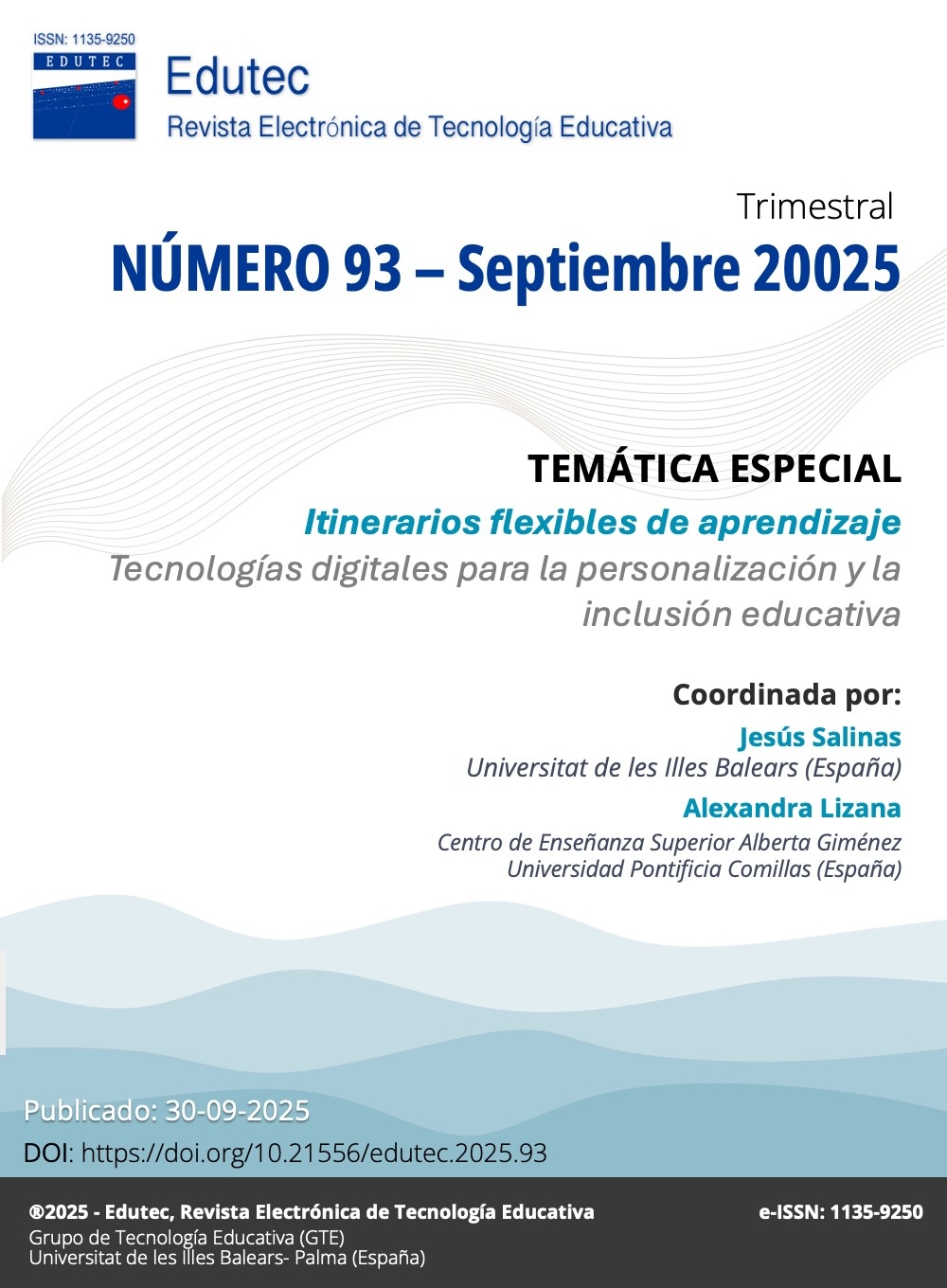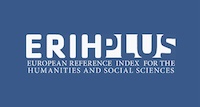AI-Enhanced Multisensory Learning Intervention to Improve Pronunciation in EFL Students
DOI:
https://doi.org/10.21556/edutec.2025.93.4197Keywords:
English, Second language learning, phonetics, language learning, educational technology, teaching methodsAbstract
Despite early exposure to English as a foreign language (EFL), Spanish learners often struggle with its pronunciation due to fundamental differences between the transparent orthography in Spanish and the deep orthography in English. This study examines the effectiveness of a multisensory learning (MSL) methodology enhanced by artificial intelligence (AI) tools and based on the dual-route model of reading, which distinguishes between sublexical decoding and lexical word recognition, in improving English pronunciation accuracy. 94 university students were divided into a target group and a control group. The intervention involved a pre-test and a post-test and a set of reading-aloud tasks, all conducted via the Wooflash platform and focused on five difficult English vowel phonemes: /ə/, /uː/, /ʌɪ/, /eɪ/, and /ɔː/. The objective was to compare the effectiveness of MSL and traditional training (TT), and to assess participants’ experiences of the MSL approach. Quantitative results showed that MSL was as effective as TT in improving pronunciation accuracy, while qualitative feedback from the post-activity questionnaire revealed emotional, cognitive and metacognitive benefits of the MSL intervention, including increased confidence and awareness of pronunciation challenges. These findings suggest the potential of MSL as a learner-centered and engaging tool for improving pronunciation in EFL contexts.
Funding
This study was supported by funding from the University of Valladolid through the Innovative Teaching Project “Mejora de la lectura en inglés mediante IA y Metodologías Multisensoriales en Estudiantes con y sin Dificultades de Aprendizaje,” during the 2024-2025 academic year.
Downloads
References
Ai, Y., Hu, Y., & Zhao, W. (2025). Interactive learning: harnessing technology to alleviate foreign language anxiety in foreign literature education. Interactive Learning Environments, 33(3), 2440–2459. https://doi.org/10.1080/10494820.2024.2409990 DOI: https://doi.org/10.1080/10494820.2024.2409990
Calvo Benzies, Y. J. (2016). The teaching and learning of English pronunciation in Spain: An analysis and appraisal of students’ and teachers’ views and teaching materials. [Doctoral dissertation, Universidade de Santiago de Compostela]. MINERVA. http://hdl.handle.net/10347/13862
Calvo Benzies, Y. J. (2017). Advanced Spanish university students problems with the pronunciation of English vowels. Identification, analysis and teaching implications. ODISEA, 14, 37–56. https://doi.org/10.25115/odisea.v0i14.256 DOI: https://doi.org/10.25115/odisea.v0i14.256
Cao, F., Kim, S. Y., Liu, Y., & Liu, L. (2014). Similarities and differences in brain activation and functional connectivity in first and second language reading: Evidence from Chinese learners of English. Neuropsychologia, 63, 275–284. https://doi.org/10.1016/j.neuropsychologia.2014.09.001 DOI: https://doi.org/10.1016/j.neuropsychologia.2014.09.001
Casillas J. (2015). Production and perception of the /i/-/I/ vowel contrast: The case of L2-dominant early learners of English. Phonetica, 72(2-3), 182–205. https://doi.org/10.1159/000431101 DOI: https://doi.org/10.1159/000431101
Chapuis, N. D., & Berthele, R. (2024). Teaching methods emphasizing phonological forms enhance L2 vocabulary learning. Language Teaching Research. https://doi.org/10.1177/13621688241270803 DOI: https://doi.org/10.1177/13621688241270803
Coltheart, M. (2006). Dual route and connectionist models of reading: an overview. London Review of Education, 4(1), 5–17. https://doi.org/10.1080/13603110600574322 DOI: https://doi.org/10.1080/13603110600574322
Coltheart, M., Rastle, K., Perry, C., Langdon, R., & Ziegler, J. (2001). DRC: A dual route cascaded model of visual word recognition and reading aloud. Psychological Review, 108(1), 204–256. https://doi.org/10.1037/0033-295X.108.1.204 DOI: https://doi.org/10.1037//0033-295X.108.1.204
Derwing, T. M., & Munro, M. J. (2015). Pronunciation fundamentals: Evidence-based perspectives for L2 teaching and research. John Benjamins Publishing Company. DOI: https://doi.org/10.1075/lllt.42
Ernesto Macaro, L. E. (2012). Decoding ability in French as a foreign language and language learning Motivation. The Modern Language Journal, 95(4), 496–518. https://doi.org/10.1111/j.1540-4781.2011.01238.x DOI: https://doi.org/10.1111/j.1540-4781.2011.01238.x
Fadillah, A. C. (2020). Pronunciation difficulties of EFL learners in Indonesia: A literature study. Jurnal Budaya FIB UB, 1(2), 7–13. https://jurnalbudaya.ub.ac.id/
Fouz-González, J. (2020). Using apps for pronunciation training: An empirical evaluation of the English File Pronunciation app. Language Learning & Technology, 24(1), 62–85. https://doi.org/10125/44709 DOI: https://doi.org/10.64152/10125/44709
García, P. B., & Froud, K. (2018). Perception of American English vowels by sequential Spanish–English bilinguals. Bilingualism: Language and Cognition, 21(1), 80–103. https://doi.org/10.1017/S1366728916000808 DOI: https://doi.org/10.1017/S1366728916000808
Gómez González, M. de los Á., & García Muras, R. (2025). EFL pronunciation instruction in Spanish primary schools: From prescribed curriculum to classroom practice. Education Sciences, 15(4), 427. https://doi.org/10.3390/educsci15040427 DOI: https://doi.org/10.3390/educsci15040427
Hsiao, J. C., & Chang, J. S. (2023). Enhancing EFL reading and writing through AI-powered tools: design, implementation, and evaluation of an online course. Interactive Learning Environments, 32(9), 4934–4949. https://doi.org/10.1080/10494820.2023.2207187 DOI: https://doi.org/10.1080/10494820.2023.2207187
Kast, M., Meyer, M., Vögeli, C., Gross, M., & Jäncke, L. (2007). Computer-based multisensory learning in children with developmental dyslexia. Restorative Neurology and Neuroscience, 25(3–4), 355–369. https://doi.org/10.3233/RNN-2007-253417 DOI: https://doi.org/10.3233/RNN-2007-253417
Kelly, K., & Phillips, S. (2022). Teaching literacy to learners with dyslexia: A multisensory approach (3rd ed.). Corwin UK.
Krashen, S. D. (1982). Principles and practice in second language acquisition. Pergamon Press.
Levis, J. M. (2005). Changing contexts and shifting paradigms in pronunciation teaching. TESOL Quarterly, 39(3), 369–388. https://doi.org/10.2307/3588485 DOI: https://doi.org/10.2307/3588485
Li, P., Baills, F., Alazard-Guiu, C., Baqué, L. & Prieto, P. (2023). A pedagogical note on teaching L2 prosody and speech sounds using hand gestures. Journal of Second Language Pronunciation, 9(3), 340–349. https://doi.org/10.1075/jslp.23043.li DOI: https://doi.org/10.1075/jslp.23043.li
Łockiewicz, M., Jaskulska, M., & Fawcett, A. (2020). Decoding and word recognition in English as a native and a foreign language in students with and without dyslexia (English vs. Polish students). Dyslexia, 26(1), 18–35. https://doi.org/10.1002/dys.1648 DOI: https://doi.org/10.1002/dys.1648
Mlakar, H., Hirst-Plein, J. & Koch, M. J. (2025). Cognitive and linguistic influences on EFL real word and pseudoword spelling: Predictors and error analysis. Languages, 10(5), 93. https://doi.org/10.3390/languages10050093 DOI: https://doi.org/10.3390/languages10050093
Mora, J. C., Ortega, M., Mora-Plaza, I., & Aliaga-García, C. (2022). Training the pronunciation of L2 vowels under different conditions: The use of non-lexical materials and masking noise. Phonetica, 79(1), 1–43. https://doi.org/10.1515/PHON-2022-2018, DOI: https://doi.org/10.1515/phon-2022-2018
Nikbakht, H. (2011). EFL pronunciation teaching: A theoretical review. The Journal of Applied Linguistics, 4(1), 146–176.
Odlin, T. (2012). Language transfer. Cambridge University Press. https://doi.org/10.1017/CBO9781139524537 DOI: https://doi.org/10.1017/CBO9781139524537
Pennington, M. C., & Rogerson-Revell, P. (2019). English pronunciation teaching and research: Contemporary perspectives. Palgrave Macmillan. DOI: https://doi.org/10.1057/978-1-137-47677-7
Permatasari, S. (2024). Enhancing pronunciation skills in EFL students through the ELSA speak application. Indonesian EFL Journal, 10(2), 205–212. https://doi.org/10.25134/ieflj.v10i2.10137 DOI: https://doi.org/10.25134/ieflj.v10i2.10137
Rallo, L. (2022). Factors affecting pronunciation accuracy in English as a foreign language: The case of Spanish Catalan intermediate learners. Atlantis. Journal of the Spanish Association for Anglo-American Studies, 44(2), 45–64. https://doi.org/10.28914/Atlantis-2022-44.2.03 DOI: https://doi.org/10.28914/Atlantis-2022-44.2.03
Rayner, K., & Reichle, E. D. (2010). Models of the reading process. Wiley Interdisciplinary Reviews: Cognitive Science, 1(6), 787–799. https://doi.org/10.1002/wcs.68 DOI: https://doi.org/10.1002/wcs.68
Saito, K. (2021). What characterizes comprehensible and native-like pronunciation among English-as-a-second-language speakers? Meta-analyses of phonological, rater, and instructional factors. TESOL Quarterly, 55(3), 866–900. https://doi.org/10.1002/tesq.3027 DOI: https://doi.org/10.1002/tesq.3027
Saito, K., & Plonsky, L. (2019). Effects of second language pronunciation teaching revisited: A proposed measurement framework and meta‐analysis. Language Learning, 69(3), 652–708. https://doi.org/10.1111/lang.12345 DOI: https://doi.org/10.1111/lang.12345
Sammour-Shehadeh, R., Prior, A., & Kahn-Horwitz, J. (2025). Spelling challenges in English as a foreign language: vowels, digraphs, and novel phonemes. Reading and Writing, 1–24. https://doi.org/10.1007/s11145-025-10659-3 DOI: https://doi.org/10.1007/s11145-025-10659-3
Seidenberg, M. S., & McClelland, J. L. (1989). A distributed, developmental model of word recognition and naming. Psychological Review, 96(4), 523–568. https://doi.org/10.1037/0033-295X.96.4.523 DOI: https://doi.org/10.1037//0033-295X.96.4.523
Selim, A. S. M. (2024). The transformative impact of AI-powered tools on academic writing: Perspectives of EFL University Students. International Journal of English Linguistics, 14(1), 14. https://doi.org/10.5539/IJEL.V14N1P14 DOI: https://doi.org/10.5539/ijel.v14n1p14
Seidlhofer, B. (2011). Understanding English as a lingua franca. Oxford University Press. DOI: https://doi.org/10.1002/9781405198431.wbeal0243
Setyaningsih, E., Asrori, M., Ngadiso, Sumardi, Zainnuri, H., & Hariyanti, Y. (2024). Exploring high school EFL teachers’ experiences with magic school AI in lesson planning: Benefits and insights. Voices of English Language Education Society, 8(3). https://doi.org/10.29408/VELES.V8I3.27700 DOI: https://doi.org/10.29408/veles.v8i3.27700
Shams, L., & Seitz, A. R. (2008). Benefits of multisensory learning. Trends in Cognitive Sciences, 12(11), 411–417. https://doi.org/10.1016/j.tics.2008.07.006 DOI: https://doi.org/10.1016/j.tics.2008.07.006
Snowling, M. J., Hulme, C., & Nation, K. (Eds.). (2022). The science of reading. Wiley Blackwell. https://doi.org/10.1002/9781119705116 DOI: https://doi.org/10.1002/9781119705116
Song, C., & Song, Y. (2023). Enhancing academic writing skills and motivation: assessing the efficacy of ChatGPT in AI-assisted language learning for EFL students. Frontiers in Psychology, 14. https://doi.org/10.3389/fpsyg.2023.1260843 DOI: https://doi.org/10.3389/fpsyg.2023.1260843
Veiga Pérez, C. (2017). Spanish teenager’s pronunciation of English as a second language. Revista de Educación de La Universidad de Granada, 24, 273–292.
Yang X., Shi F., Liu X., Zhao Y. (2016). Learning styles and perceptual patterns for English /i/ and /I/ among Chinese college students. Applied Psycholinguistics, 37(3), 673–701. https://doi.org/10.1017/S014271641500020X DOI: https://doi.org/10.1017/S014271641500020X
Yuan, L., & Liu, X. (2025). The effect of artificial intelligence tools on EFL learners’ engagement, enjoyment, and motivation. Computers in Human Behavior, 162, 108474. https://doi.org/10.1016/j.chb.2024.108474 DOI: https://doi.org/10.1016/j.chb.2024.108474
Zhang, Z., & Peng, P. (2022). Reading real words versus pseudowords: A meta-analysis of research in developmental dyslexia. Developmental Psychology, 58(6), 1035–1050. https://doi.org/10.1037/dev0001340 DOI: https://doi.org/10.1037/dev0001340
Ziegler, J. C., & Goswami, U. (2005). Reading acquisition, developmental dyslexia, and skilled reading across languages: A psycholinguistic grain size theory. Psychological Bulletin, 131(1), 3–29. https://doi.org/10.1037/0033-2909.131.1.3 DOI: https://doi.org/10.1037/0033-2909.131.1.3
Zlatkova-Doncheva, K. (2022). A multisensory approach to teaching students with dyslexia. Pedagogical Almanac, 30(1), 70–78. https://doi.org/10.54664/xuav9711 DOI: https://doi.org/10.54664/XUAV9711
Published
How to Cite
Issue
Section
License
Copyright (c) 2025 Edutec, Revista Electrónica de Tecnología Educativa

This work is licensed under a Creative Commons Attribution 4.0 International License.
By submitting the paper, the authors assign the publication rights to the journal Edutec. For its part, Edutec authorises its distribution as long as its content is not altered and its origin is indicated. At the end of each article published in Edutec, the citation procedure is indicated.
The management and editorial board of Edutec Revista Electrónica de Tecnología Educativa do not accept any responsibility for the statements and ideas expressed by the authors in their work.
Translated with www.DeepL.com/Translator (free version)









